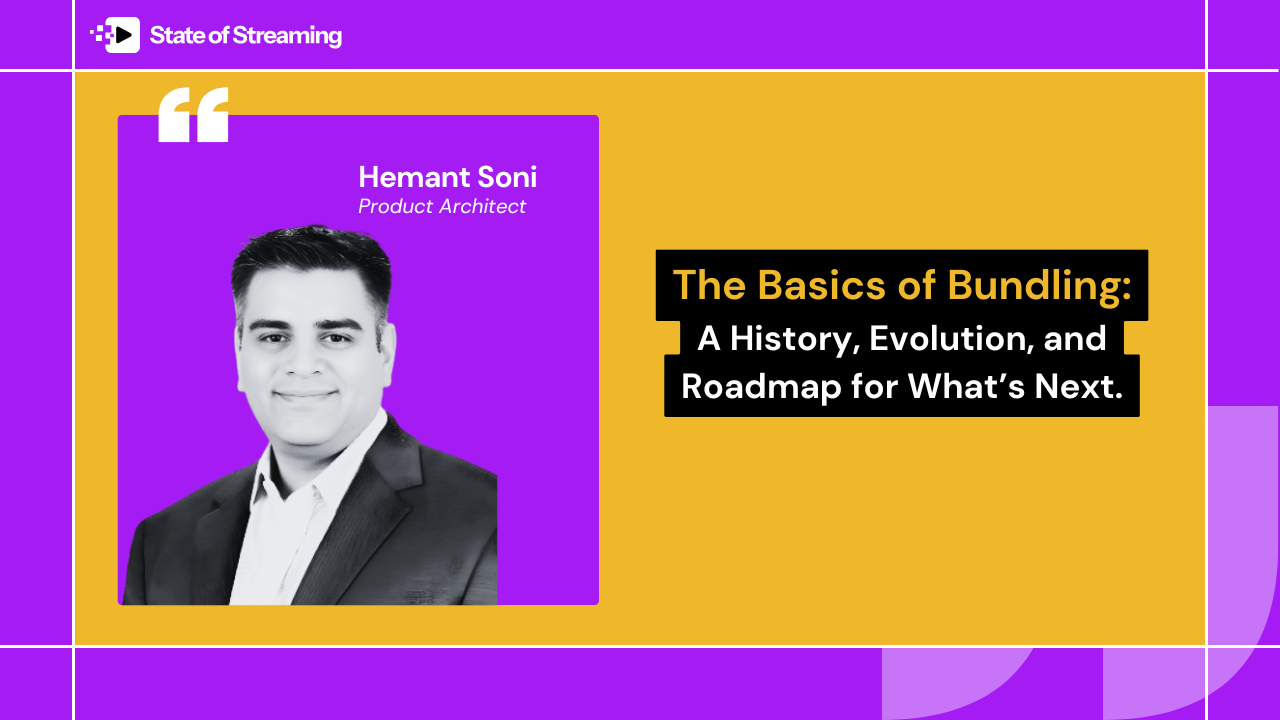An introductory series exploring the dynamics of bundling - where we've been, where we are, where we're going, and why
Everyone loves a bundle.
Shopping for car insurance? Bundle it with your home or renter's policy.
Got a boat? There's a bundle for that too.
Just as in the insurance industry, bundling has long been a cornerstone strategy for the companies we pay for connectivity and the content we love most.
What is Bundling and Why Do Companies Use It?
Bundling combines multiple services or products into a single package, typically at a discount compared to purchasing items separately. Traditionally, combinations like Phone + Internet or TV + Internet were offered to simplify billing and boost customer retention. While bundling can serve as a pricing mechanism for capturing economic surplus from consumers, it also appears in competitive markets, particularly due to the cost structures in media industries.
Typically, companies use two main bundling strategies:
Pure Bundling - Only the package is available, not individual components. T-Mobile is a great example, bundling unlimited talk, text, and data alongside streaming services like Netflix. Similarly, Verizon offers unlimited 5G data, talk, and text with access to Disney+, Hulu, and ESPN+, perks that are exclusively available as part of the bundle.
Mixed Bundling - In this scenario, products are sold both individually and as part of a bundle. AT&T demonstrates this approach by allowing customers to purchase internet, TV, and phone services separately or as a discounted package that includes high-speed internet, DIRECTV, and home phone services.
Let’s take a closer look at how bundling has evolved over time to today.
The Evolution of Bundling
In its early form, bundling focused on convenience. Providers combined services like home phone and internet, or TV and broadband into a single bill. This simplified billing for customers and helped companies retain users by offering higher value at a lower combined cost. As telecom and cable companies expanded, so did their offerings, leading to the rise of "triple play" (TV, internet, phone) and "quad play" (adding mobile to the triple play).
However, the concept has evolved significantly due to two major inflection points: the rise of digital convergence and shifting consumer expectations.
Digital Convergence: The Game Changer
Digital Convergence refers to the merging of previously separate media, technology, and devices into a single, unified platform, often underpinned by increased connectivity and technological advancements. As an example, Apple embodies digital convergence in their approach to merging consumer hardware with media to create a truly connected consumer ecosystem.
This convergence has pushed former network monopolists to enter each other's markets, often leading with bundled service offerings. Triple-play bundles typically include voice, television, and internet services, adopted by both cable Multiple System Operators (MSOs) and telephone companies. Comcast Xfinity demonstrates this with their triple-play bundle combining high-speed internet, digital TV signal (better picture and sound quality), and home phone services in an all-in-one package designed to meet communication and entertainment needs.
Shifting Consumer Expectations
The telecommunications bundling landscape has become increasingly competitive, with mobile services emerging as a leading factor in provider selection. Because of this, companies like Verizon, Cox, Charter, and AT&T offer comprehensive bundles that include mobile services, high-speed internet, and digital TV which has proved to be valuable in winning and holding market share.
The Rise of No-Contract Bundles
No-contract bundles are gaining popularity due to their flexibility, cost savings, and customizable options:
- Comcast Xfinity offers no-contract broadband plans with unlimited data, a Wi-Fi gateway, and a free line of Xfinity Mobile for one year
- Verizon provides no-contract bundles that include high-speed internet, digital TV, and mobile services
- T-Mobile delivers no-contract bundles with unlimited talk, text, and data, along with streaming services like Netflix
These bundles appeal to customers seeking comprehensive solutions without long-term commitments, enhancing both convenience and satisfaction.
The Streaming Services Factor
Over 70% of consumers consider the quality of mobile service as the biggest factor when selecting a bundling provider, essentially viewing it as a one-stop shop. Additionally, the popularity of bundled streaming services like Netflix and Disney+ has further influenced consumer choices. In fact, some consumers now prioritize streaming services over broadband internet when selecting their bundles.
Rural and Remote Considerations
Customers in remote areas are seeking reliable service and exploring satellite alternatives. Satellite internet services like Starlink have emerged as viable options, providing comprehensive coverage across the United States. While Starlink is currently pricier than traditional fixed packages, competition from companies like Amazon could drive prices down over the next decade.
Current estimates suggest that 94-96% of all US Households have an internet connection with at least one streaming service.
What is “lock-in" and why does it matter?
Lock-in occurs when customers feel obligated to remain with a specific service provider due to high switching costs or other obstacles. In the US telecom market especially, this significantly influences customer retention and loyalty. Lock-in is particularly relevant given the popularity of no-contract plans, which allow customers to switch providers easily.
To counteract this flexibility, telecom companies often use bundles and price freezes to keep customers engaged and loyal. This year, in 2025, the US market is seeing new behavior and trends emerge related to lock-in and no-contract plans. Service providers are increasingly using price freezes and service bundles to retain customers, while long-term contracts are becoming less common.
Current No-Contract Bundle Examples:
- Verizon Fios: Fast internet speeds, extensive TV options, and flexible mobile plans starting at $89.99/month
- Xfinity: High-speed internet, TV channels, and mobile plans starting at $79.99/month
- AT&T: Competitive bundles with high-speed internet, TV packages, and mobile services starting at $69.99/month
- Spectrum: Reliable internet, TV channels, and unlimited mobile data starting at $50/month
Today, the market is mature and saturated, with high smartphone penetration leading to a focus on customer retention and loyalty. Technological advancements like 5G and IoT are driving growth, while the presence of Multi-Service Operators (MSOs) and Mobile Virtual Network Operators (MVNOs) is increasing competitive pressure.
The Strategic Value of Bundling
Bundling serves as a powerful leverage device for firms, enhancing quality differentiation and reducing the intensity of price competition. It helps reduce customer churn and increase profit for companies while being utilized to transition customers to next-generation services. Technological advancements are often cited for the use of bundling in service provision, with service providers aiming to transition long-term users to next-generation networks through bundling promotions, often at minimal or no cost.
From a consumer perspective, bundling provides opportunities for one-stop-shopping, which reduces transaction costs. Offering bundled services also allows for growth by introducing new products while minimizing the churn rate of existing ones. Furthermore, bundling has been shown to increase demand for services, particularly for information goods where it serves as a value-based pricing strategy.
Why It Matters
Bundling is no longer just about saving money—it's about creating a seamless, integrated experience for consumers. For providers, it's a strategic lever to remain competitive in a rapidly converging market. As technology and consumer expectations evolve, bundling will continue to play a central role in shaping how we connect, communicate, and consume content.
Final Thoughts
Bundling has evolved from a simple pricing tactic to a sophisticated strategy driven by digital convergence and consumer preferences. It enhances customer loyalty, reduces operational costs, and opens doors for cross-selling and innovation. For consumers, it simplifies decision-making and often delivers better value. For providers, it's a strategic lever to differentiate in an increasingly crowded and converging marketplace.
As the competitive landscape continues to shift, future bundling strategies will likely focus on flexibility, personalization, and ecosystem value, offering consumers seamless access to content, connectivity, and devices under a unified experience.

